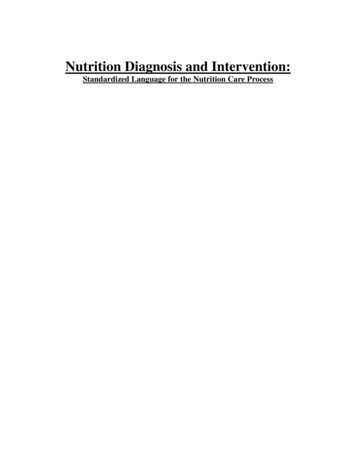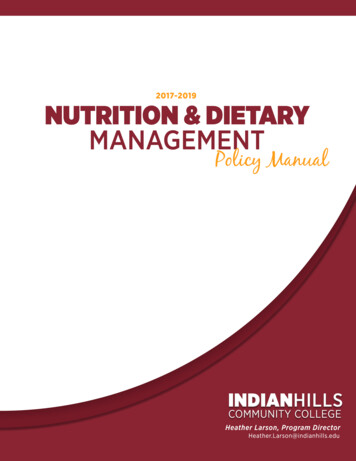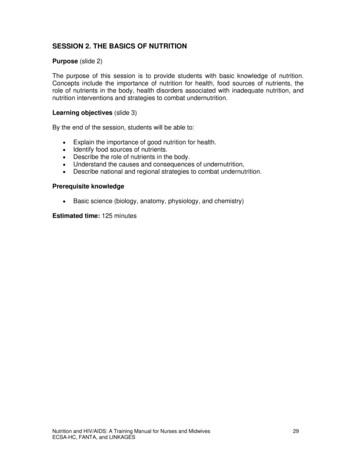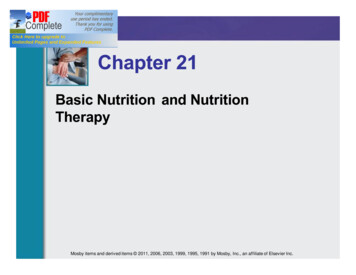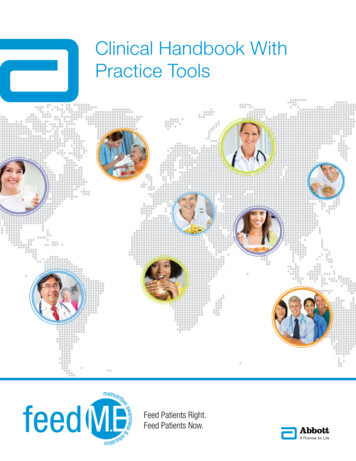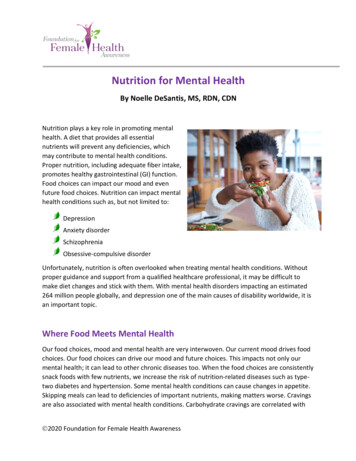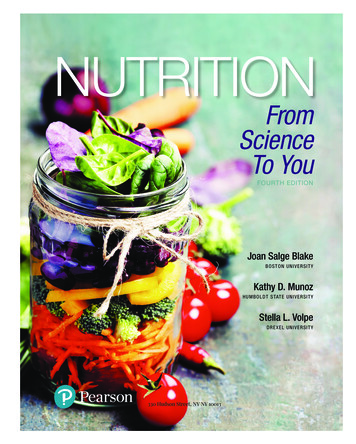
Transcription
NUTRITIONFromScienceTo YouFOURTH EDITIONJoan Salge BlakeBOSTON UNIVERSITYKathy D. MunozH U M B O L D T S TAT E U N I V E R S I T YStella L. VolpeDREXEL UNIVERSITY330 Hudson Street, NY NY 10013A01 BLAK8260 04 SE FM.indd 112/1/17 9:17 PM
Courseware Portfolio Manager: Michelle YgleciasContent Producer: Lizette FarajiManaging Producer: Nancy TaborCourseware Director, Content Development: Barbara YienDevelopment Editor: Laura BonazzoliCourseware Editorial Assistant: Nicole Constantine, Crystal TriguerosRich Media Content Producer: Lucinda BinghamFull-Service Vendor: SPi GlobalCopyeditor: Laura PatchkovskyCompositor: SPi GlobalArt Coordinator: Morgan Ewald, Lachina Publishing ServicesDesign Manager: Mark OngInterior Designer: Gary HespenheideCover Designer: Gary HespenheideRights & Permissions Project Manager: Linda DeMasi, Cenveo Publishing ServicesRights & Permissions Management: Ben FerriniPhoto Researcher: Clare MaxwellManufacturing Buyer: Stacey Weinberger, LSC CommunicationsExecutive Product Marketing Manager: Neena Bali, Alysun BurnsField Marketing Manager: Mary SalzmanPrinter/Binder: LSC Communications, Inc.Cover Printer: Phoenix Color/HagerstownCover Photo Credit: Natalia Klenova/ShutterstockCopyright 2019, 2016, 2012 Pearson Education, Inc. All Rights Reserved. Printed in theUnited States of America. This publication is protected by copyright, and permission should beobtained from the publisher prior to any prohibited reproduction, storage in a retrieval system,or transmission in any form or by any means, electronic, mechanical, photocopying, recording,or otherwise. For information regarding permissions, request forms and the appropriate contactswithin the Pearson Education Global Rights & Permissions department, please visit www.pearsoned.com/permissions/.Acknowledgements of third party content appear on page CR-1, which constitutes an extensionof this copyright page.PEARSON, ALWAYS LEARNING, and MasteringTM Nutrition are exclusive trademarks in theU.S. and/or other countries owned by Pearson Education, Inc. or its affiliates.Unless otherwise indicated herein, any third-party trademarks that may appear in this work arethe property of their respective owners and any references to third-party trademarks, logos orother trade dress are for demonstrative or descriptive purposes only. Such references are notintended to imply any sponsorship, endorsement, authorization, or promotion of Pearson’sproducts by the owners of such marks, or any relationship between the owner and Pearson Education, Inc. or its affiliates, authors, licensees or distributors.Cataloging-in-Publishing data is on file with the Library of CongressNames: Blake, Joan Salge, author. Munoz, Kathy D., 1951- author. Volpe,Stella, 1963- author.Title: Nutrition : from science to you / Joan Salge Blake (BostonUniversity), Kathy D. Munoz (Humboldt State University), Stella L. Volpe(Drexel University).Description: Fourth edition. New York : Pearson, [2019]Identifiers: LCCN 2017056138Subjects: LCSH: Nutrition–Textbooks.Classification: LCC RA784 .B553 2019 DDC 613.2–dc23LC record available at https://lccn.loc.gov/2017056138ISBN 10: 0-13-466826-X; ISBN 13: 978-0-134-66826-0 (Student edition)ISBN 10: 0-134-79645-4; ISBN 13: 978-0-134-79645-1 (Instructor’s Review Copy)117www.pearson.comA01 BLAK8260 04 SE FM.indd 212/1/17 9:17 PM
Brief Contents123456789101112131415161718192021What Is Nutrition? 3Tools for Healthy Eating 39Digestion, Absorption, and Transport 75Carbohydrates 111Lipids 157Proteins 205Alcohol 247Energy Metabolism 281Fat-Soluble Vitamins 317Water-Soluble Vitamins 359Water 405Major Minerals 433Trace Minerals 469Energy Balance and Body Composition 507Weight Management 537Nutrition and Fitness 577Life Cycle Nutrition: Pregnancy through Infancy 619Life Cycle Nutrition: Toddlers through Adolescents 665Life Cycle Nutrition: Older Adults 697Food Safety, Technology, and Sustainability 731Global Nutrition and Malnutrition 779AMetabolism Pathways and Biochemical StructuresBCalculations and ConversionsCU.S. Exchange Lists for Meal PlanningDOrganizations and ResourcesA-3B-1C-1D-1iiiA01 BLAK8260 04 SE FM.indd 312/1/17 9:17 PM
Contents1How Healthy Is the Average American Diet? 22The Quality of the American Diet Needs ImprovementWhat Is Nutrition? 3What Drives Our Food Choices? 4Taste and EnjoymentCulture andEnvironmentWhat Is Credible Nutrition Research? 24Social Life and TrendsAdvertisingHealthy People 2020 Provides Health Objectives forAmericans 2345Nutrition KnowledgeSound Nutrition Research Begins with the ScientificMethod 2456Scientists Use a Variety of Experiments to TestHypotheses 266Time, Convenience,and Cost 6Habits and Emotions22Rates of Overweight and Obesity in Americans Are TooHigh 23HEALTHCONNECTION: How Can You Find and RecognizeCredible Nutrition Information? 287Seek Information from Nutrition ExpertsWhat Is Nutrition? 7Beware of QuackeryNutrients Are EssentialCompounds in Food 828Evaluate Nutrition News with a Critical Eye29Know How to Evaluate Nutrition Informationon the Internet 29Most Nutrients AreOrganic 8Visual Chapter Summary 31What Are the Primary Roles of the Six Classes ofNutrients? 12Carbohydrates Are the Primary Energy SourceLipids Also Provide Energy2812213Proteins Provide the Building Blocks for TissueSynthesis 13Vitamins and Minerals Play Vital Roles in MetabolismWater Is Critical for Numerous Functions1314How Can You Be Sure to Meet Your NutritionalNeeds? 15The Best Approach Is to Consume a Balanced Diet15Some Nutrient Needs Can Be Met with Fortified Foods ora Supplement 16How Does Diet Influence Your Health? 16A Healthy Diet Reduces the Risk of Chronic Disease16A Healthy Diet Prevents Nutrient-Deficiency Diseases17A Healthy Diet Can Positively Affect Gene Expression17How Do We Assess Nutritional Status? 18Tools for Healthy Eating 39What Are the KeyPrinciples of HealthyEating? 40Healthy Eating MeansBalance between FoodGroups 40Healthy Eating MeansConsuming a Variety ofFoods 41Healthy Eating MeansModerate Intake of AllFoods 41The ABCD Method Is Used to Assess the Nutritional Status of Individuals 19Healthy Eating IncludesNutrient-DenseFoods 41Surveys Are Used to Assess the Nutritional Status of aPopulation Group 21Healthy Eating Includes Low-Energy-DenseFoods 42ivA01 BLAK8260 04 SE FM.indd 412/1/17 9:17 PM
How Is Food Propelled through the GI Tract? 84How Is Food Chemically Digested? 86Many Resources Are Available for Planninga Healthy Diet 43What Are the Dietary Reference Intakes? 44The DRIs Encompass Several Reference ValuesEnzymes Drive the Process of Digestion45Certain Secretions Are Essential for Digestion46FOCUS Figure 2.2 Dietary Reference IntakesYou Can Use the DRIs to Plan a Quality DietThere Are Four Mechanisms of Nutrient Absorption 90Fluid Absorption Occurs in the Large Intestine51Hormones in the GI Tract Regulate DigestionWhat Is the Exchange System? 55What Information Is on the Food Label? 58Food Labels Are Strictly Regulated by the FDAFOCUS Figure 2.9 The Nutrition Facts PanelHow Are Nutrients Transported throughoutthe Body? 96The Cardiovascular System DistributesNutrients through Blood 9659The Lymphatic System Distributes Some Nutrientsthrough the Lymph 9760The Percent Daily Values Help You Compare PackagedFoods 61Label Claims Can Reveal Potential Health Benefits62HEALTHCONNECTION: Portion Distortion 65Portion versus Serving Size: What’s the Difference?6566Health Effects of Increased Portion Size94The Enteric Nervous System Communicates Within andBeyond the GI Tract 9558The Nutrition Facts Panel Indicates Nutrient ValuesTips for Controlling Portion Size93How Do Hormones and the Nervous SystemRegulate Digestion? 93Use MyPlate to Choose Foods that Fit Your KilocalorieNeeds 53How Have Portion Sizes Changed?89How Are Digested Nutrients Absorbed? 9047What Are the Dietary Guidelines forAmericans? 49What Is MyPlate? 49MyPlate Emphasizes Changes in Diet866666The Excretory System Eliminates WasteHEALTHCONNECTION: What Are Some Common DigestiveDisorders? 98Esophageal Problems98Disorders of the Stomach98Gallbladder Disease 99Celiac Disease 99Other Intestinal DisordersVisual Chapter Summary 6897101Visual Chapter Summary 1053Digestion, Absorption,and Transport 75What Are the Processes and Organs Involved inDigestion? 76Digestion Begins in the MouthFOCUS Figure 3.1The Digestive System77Carbohydrates 111What Are Carbohydrates and How AreThey Classified? 112Monosaccharides AreSingle Sugar Units 113Disaccharides Consist ofTwo Sugar Units 113The Stomach Stores,Mixes, and PreparesFood for Digestion 78OligosaccharidesHave Three to Ten SugarUnits 116Most Digestion Occurs inthe Small Intestine 79Polysaccharides Consist of Many SugarUnits 117FOCUS Figure 3.6Structures of the SmallIntestinal Wall 80How Do WeDigest and AbsorbCarbohydrates? 120The Large IntestineAbsorbs Water andSome Nutrients 81The Accessory OrgansSecrete Digestive Juices764Digestion of Carbohydrates Begins in the Mouth84120Carbohydrates Are Absorbed as Monosaccharides120FOCUS Figure 4.8 Carbohydrate Digestion and Absorption121Contents vA01 BLAK8260 04 SE FM.indd 512/1/17 9:17 PM
What Functions Do CarbohydratesPerform in the Body? 122Carbohydrates Provide EnergyCarbohydrates Spare ProteinTriglycerides Are the MostCommon Lipid 162Phospholipids Differ fromTriglycerides 164123123Carbohydrates Prevent Ketosis123How Do We Maintain Blood Glucose Levels? 124Insulin Regulates Glucose in the Blood124Glucagon Regulates Liver Glycogenolysis124Four Other Hormones Help Regulate GlucoseMetabolism 124FOCUS Figure 4.10 Hormones Regulate Blood Glucose125Hypoglycemia Results When Blood GlucoseDrops below Normal 126Dietary Fiber Helps Prevent Cardiovascular Disease, Diabetes, and Cancer 127129Whole Plant Foods and Dairy Products Are Good Sourcesof Carbohydrates 130Packaged Foods Can Be Good Sources ofCarbohydrates 132How Do Natural Sugars, Added Sugars, and SugarSubstitutes Differ? 134Foods with Natural Sugars Are Generally More NutrientDense 134Added Sugars Are Used during Food Processing136Sugar Substitutes Add Sweetness but NotKilocalories 136Control Is Key146146147What Are the Functions of Lipidsin the Body? 172Fatty Acids Are Used for Energy172Dietary Fat Aids the Absorption of Lipid Compounds 173135Essential Fatty Acids Manufacture Eicosanoidsand Maintain Cell Membranes 173Cholesterol Is Used to Make Hormones, Bile,and Vitamin D 174Phospholipids and Cholesterol Make Up CellMembranes 174What Are the Recommendations for Daily Intake ofTriglycerides and Cholesterol? 175Dietary Cholesterol and Phospholipids Are NotEssential 177What Are the Best, Worst, and Alternative FoodSources for Fat? 181The Best Food Sources Are Low in Saturated FatVisual Chapter Summary 148181Reduce Foods That Contain Trans Fat 1855Increase Plant Sterols and Stanols187Fat Substitutes Lower Fat in Foods188HEALTHCONNECTION: What Is Heart Disease and What Factors Increase Risk? 190Lipids 157What Are Lipids and How Do They Differ inStructure? 158Most Lipids Are Composed of Fatty Acids171Essential Fatty Acids Have SpecificRecommendations 177141143Preventing Type 2 Diabetes169Dietary Fat Intake Is Based on a Percentage of TotalKilocalories 175HEALTHCONNECTION: What Is Diabetes? 141Diabetes Can Result in Long-Term DamageLipoproteins Transport LipidsTriglycerides Stored in Adipose Tissue Insulate the Bodyand Protect Vital Organs 173Glycemic Index and Glycemic Load Can Be Usedfor Meal Planning 133FOCUS Figure 4.22 DiabetesChylomicrons Facilitate Lipid Absorptioninto the Lymph 167FOCUS Figure 5.15 Lipoprotein Transport and DistributionWhat Are the Recommendations for CarbohydrateIntake and the Best Food Sources? 129Diabetes Types and Risk FactorsFOCUS Figure 5.10Lipid Digestion andAbsorption 166Most Triglycerides Are Digested and Preparedfor Absorption in the Small Intestine 167Dietary Fiber Helps Prevent Constipation andDiverticulosis 127Sugar Can Cause Dental CariesHow Are LipidsDigested, Absorbed,and Transported in theBody? 165Triglyceride Digestion Begins in the Mouth andStomach 167Why Is Dietary Fiber So Importantfor Promoting Health? 127Dietary Fiber Helps Prevent ObesitySterols Are More Complexthan Triglycerides 165158Heart Disease Begins with AtherosclerosisSome Risk Factors Are Not ControllableFOCUS Figure 5.22 Atherosclerosis190190191vi ContentsA01 BLAK8260 04 SE FM.indd 612/1/17 9:17 PM
Some Risk Factors Are ControllableHow Much Protein Do You Need Daily? 221192Modify Your Diet to Lower Your Risk of HeartDisease 192Healthy Adults Should Be in Nitrogen Balance221You Can Determine Your Own Protein NeedsExercise, Manage Your Weight, and Quit Smoking195Visual Chapter Summary 198223What Are the Best Food Sourcesof Protein? 225Not All Protein Is Created Equal225Many Healthy Foods Provide Significant Protein6Most People Don’t Need Protein SupplementsWhat Happens If You Eat Too Much or Too LittleProtein? 232Proteins 205What Are Proteins? 206Eating Too Much Protein May Contribute to ChronicDisease 232The Building Blocks ofProteins Are AminoAcids 206Eating Too Little Protein Can Lead to Protein-EnergyMalnutrition 234The Organization andShape of Proteins AffectTheir Function 208HEALTHCONNECTION: What Is a Vegetarian Diet? 236Balanced Vegetarian Diets Confer Health BenefitsA Healthy Vegetarian Diet Requires PlanningDenaturation of ProteinsChanges TheirShape 2107Alcohol 247Protein Digestion Beginsin the Stomach 211What Is Alcohol and How Is It Made? 248Protein Digestion Continues in the Small IntestineAmino Acids Are Absorbed in the Small Intestine211211How Are Amino Acids Metabolized? 213FOCUS Figure 6.8 Protein SynthesisAdvertisements Encourage Alcohol Consumption214Deamination Removes the Amine Group from AminoAcids 216How Is Alcohol Absorbed, Circulated,and Metabolized in the Body? 252Nonessential Amino Acids Are Synthesized throughTransamination 216Alcohol Is Absorbed in the Stomach and SmallIntestine 252217Alcohol Is Metabolized in the Stomach and the LiverWhat Are the Functions of Proteinin the Body? 217Gender, Genetics, andEthnicity Affect AlcoholMetabolism 255218Proteins Help Regulate Fluid Balance218218Proteins Help Regulate Acid–Base Balance219Proteins Transport Substances throughout the Body220Proteins Can Provide Energy220Protein Improves Satiety and Appetite Control252Alcohol Circulates in theBlood 254Proteins Provide Structural Support and EnableMovement 218Proteins Act as Chemical Messengers251Moderate Drinking Is Measured in Termsof a Standard Drink 251215Excess Protein Is Converted to Body Fat248Alcohol Begins with Sugar 249People Drink to Relax, Celebrate,and Socialize 250Amino Acid Pools Allow Protein Synthesis onDemand 213Protein Synthesis Is Regulated by GenesAlcohol Has Many FormsWhy Do People Drink Alcohol and What IsConsidered a Standard Drink? 250212FOCUS Figure 6.6 Protein Digestion and AbsorptionProteins Contribute to aHealthy Immune System236237Visual Chapter Summary 240What Are the KeySteps in Digesting and Absorbing Protein? 211Proteins Act as Catalysts229230221219What Are the ShortTerm Effects of Alcohol Consumption on theBody? 256Alcohol Affects theBrain 256Alcohol CausesHangovers 258Contents viiA01 BLAK8260 04 SE FM.indd 712/1/17 9:17 PM
What Are the Effects of Chronic Excessive AlcoholConsumption on the Body? 259During the Postabsorptive State, Metabolism FavorsEnergy Production 302FOCUS Figure 8.16 Metabolism during thePostabsorptive State 303Alcohol Can Interfere with Digestion, Absorption, andNutrition 260Alcohol Can Cause Liver DiseaseAlcohol and Depression263How Does the Body Metabolize Alcohol? 306264Alcohol and Cardiovascular DiseaseAlcohol Contributes to Cancer RiskAlcohol Can Put a Pregnancy at RiskAlcohol Is Metabolized via Three Pathways265Excess Alcohol Is Stored as Fat268306307HEALTHCONNECTION: What Are Genetic Disordersof Metabolism? 308268HEALTHCONNECTION: What Is AlcoholUse Disorder (AUD)? 269Phenylketonuria308Maple Syrup Urine DiseaseAlcohol Use Disorder Can Be Treated But Not Cured271HomocystinuriaVisual Chapter Summary 273Galactosemia309309309Glycogen Storage Disease310Visual Chapter Summary 31189Energy Metabolism 281Fat-Soluble Vitamins 317What Is Metabolism? 282Metabolism Is a Series of Chemical ReactionsMetabolism Takes Place within Cells282What Are Vitamins? 318283The Liver Plays a Central Role in MetabolismEnzymes and Hormones Regulate MetabolismVitamins Were Discovered about 100 Years Ago284There Are Criteria for Classifying Vitamins284All Vitamins Are Organic, but Differ in Structure andFunction 319How Does ATP Fuel Metabolism? 285Adenosine Triphosphate Is the Cell’s Energy Source285ATP Can Be Regenerated from ADP and CreatinePhosphate 286How Do the Macronutrients Provide ATP? 287320How Do Vitamins Differ in Their Absorption andStorage? 320Fat-Soluble Vitamins Are Stored after They AreAbsorbed 321Water-Soluble Vitamins Are Not Stored afterAbsorption 321Amino Acids and GlycerolCan Yield Pyruvate 290What Are Antioxidants? 322What’s the Best Source of Vitamins? 324Pyruvate Is Transformedinto Acetyl CoA 293Vitamins Can Be Destroyed during Cooking orStorage 325Fatty Acids Can BeConverted to AcetylCoA 294Some Foods Are Fortified with Vitamins326EXPLORING Vitamin A 328Amino Acids Can BeConverted to AcetylCoA 295What Is Vitamin A? 328Vitamin A Absorption andTransport 330Metabolic Functions ofVitamin A 330The Tricarboxylic Acid (TCA) Cycle ReleasesHigh-Energy Electrons 295296How Does Metabolism Change during the Absorptive and Postabsorptive States? 300During the Absorptive State, Metabolism Favors EnergyStorage 300FOCUS Figure 8.15 Metabolism during theAbsorptive State 301Overconsumption of Some Vitamins Can Be ToxicVitamins Differ in Bioavailability 320Glycolysis Transforms Glucose to Pyruvate 287The Electron Transport Chain and OxidativePhosphorylation Produce the Majority of ATP318319FOCUS Figure 9.7 Retinal andIts Role in Vision 331Daily Needs forVitamin A 332Food Sources ofVitamin A 333Vitamin A Toxicity 334Vitamin A Deficiency 334viii ContentsA01 BLAK8260 04 SE FM.indd 812/1/17 9:17 PM
EXPLORING Vitamin DNiacin Toxicity and Deficiency335What Is Vitamin D? 335Vitamin D Metabolism 336Metabolic Functions of Vitamin DDaily Needs for Vitamin D 338Food Sources of Vitamin D 338Vitamin D Toxicity 339Vitamin D Deficiency 339EXPLORING Vitamin EEXPLORING Pantothenic AcidWhat Is Pantothenic Acid? 373Metabolic Functions of Pantothenic Acid 373Daily Needs for Pantothenic Acid 373Food Sources of Pantothenic Acid 373Pantothenic Acid Toxicity and Deficiency 374336EXPLORING Biotin 374342What Is Biotin? 374Metabolic Functions of Biotin 374Daily Needs for Biotin 375Food Sources of Biotin 375Biotin Toxicity and Deficiency 375What Is Vitamin E? 342Vitamin E Absorption and Transport 342Metabolic Functions of Vitamin E 342Vitamin E Toxicity 343Vitamin E Deficiency 344EXPLORING Vitamin KEXPLORING Vitamin B6 376345What Is Vitamin K? 345Vitamin K Absorption and Transport 345Daily Needs for Vitamin K 346Food Sources of Vitamin K 346Vitamin K Toxicity and Deficiency 346HEALTHCONNECTION: Are Vitamin Supplements Necessaryfor Good Health? 348Supplements Do Not Reduce Risks for CVD, Cancer,or Cognitive Decline 348Vitamin Supplements Are Not a Substitutefor Healthy Eating 348Supplements May Be Helpful for Some Individuals 349Supplements Are Not Regulated Like Drugs 349Visual Chapter Summary 35110Water-Soluble Vitamins 359What Are Water-Soluble Vitamins? 360Properties of Water-Soluble Vitamins360The Primary Functions of Water-Soluble VitaminsEXPLORING Thiamin (Vitamin B1) 364What Is Thiamin (B1) 364Metabolic Functions of Thiamin 365Daily Needs for Thiamin 365Food Sources of Thiamin 365Thiamin Toxicity and Deficiency 365EXPLORING Riboflavin ( Vitamin B2)366What Is Riboflavin (B2) 366Metabolic Functions of Riboflavin 367Daily Needs for Riboflavin 368Food Sources of Riboflavin 368Riboflavin Toxicity and Deficiency 368EXPLORING Niacin (Vitamin B3)369What Is Niacin (B3) 369Metabolic Functions of NiacinDaily Needs for Niacin 370Food Sources of Niacin 371371373361What Is Vitamin B6? 376Metabolic Functions ofVitamin B6 376Vitamin B6 and AminoAcid Metabolism 376Daily Needs for VitaminB6 377Food Sources of VitaminB6 377Vitamin B6 Toxicity andDeficiency 378EXPLORING Folate 378What Is Folate? 378Metabolic Functions ofFolate 379Daily Needs for Folate 380Food Sources of Folate 380Folate Toxicity and Deficiency381EXPLORING Vitamin B12 382What Is Vitamin B12? 382Metabolic Functions of Vitamin B12 382Daily Needs for Vitamin B12 383Food Sources of Vitamin B12 384Vitamin B12 Toxicity and Deficiency 385EXPLORING Vitamin C 387What Is Vitamin C? 387Metabolic Functions of Vitamin C 387Daily Needs for Vitamin C 388Food Sources of Vitamin C 388Vitamin C Toxicity and Deficiency 389What Are Other Vitamin-Like Compounds? 391Choline Helps Protect the Liver391Carnitine, Lipoic Acid, and Inositol Are Neededfor Overall Health 392HEALTHCONNECTION: Do Antioxidant Nutrients and Phytochemicals Reduce the Risk of Cancer? 392Carcinogenesis: The Cancer Process370393Physical Activity, O besity, and Cancer Risk393The Role of Diet in Cancer Risk and Progression394Visual Chapter Summary 397Contents ixA01 BLAK8260 04 SE FM.indd 912/1/17 9:17 PM
1112Why Is Water Essential to Life? 406What Are Minerals? 434Water 405Major Minerals 433Water Is a Universal Solvent and Transport MediumWater Helps Maintain Body Temperature407Minerals Are Inorganic Elements434407Minerals Vary in Their Bioavailability434Water Is a Lubricant and a Protective Cushionand Provides Structure to Muscle Cells 408Minerals Serve Numerous Functions436Water Participates in Hydrolysis and CondensationReactions 408EXPLORING Sodium 438Water Plays a Role in Acid–Base BalanceMinerals Can Be Toxic409How Is Water Balance Maintained? 409Sources of Body Water Include Beveragesand Food 410Water Is Excreted through the Kidneys, Large Intestine,Lungs, and Skin 410Body Water Is Balanced between FluidCompartments 411Electrolytes Participate in Fluid BalanceProteins Help Regulate Fluid BalanceWhat Is Sodium? 438Absorption, Transport, and Excretion of SodiumMetabolic Functions of Sodium 438Daily Needs for Sodium 439Food Sources of Sodium 440Sodium Excess 440Sodium Deficiency 442438EXPLORING Chloride 442What Is Chloride? 442Metabolic Functions ofChloride 442Daily Needs forChloride 443Food Sources ofChloride 443Chloride Toxicity andDeficiency 443411413How Do Water and Sodium Affect BloodPressure? 414ADH Helps StimulateFluid Intake and ReduceUrine Output 414Renin Helps the BodyReabsorb Water andSalts 414EXPLORING Potassium 443What Is Potassium? 443Potassium Balance in theBody 443Metabolic Functions ofPotassium 443Daily Needs for Potassium 444Food Sources of Potassium 444Potassium Toxicity and DeficiencyAldosterone Stimulates SodiumReabsorption 414How Much Water DoYou Need and What Arethe Best Sources? 416Do Diuretics Like Caffeine and Alcohol AffectFluid Balance? 420444EXPLORING Calcium 446What Is Calcium? 446Bioavailability and Absorptionof Calcium 446Hormones Regulate Calcium Balance 446Metabolic Functions of Calcium 446Caffeine Does Not Cause SignificantLoss of Body Water 420Alcohol Can Be Dehydrating436420Diuretic Medications Can Help Treat Hypertension420HEALTHCONNECTION: What Are the Effectsof Too Much or Too Little Water? 421Daily Needs for Calcium 448Food Sources of Calcium 448Calcium Toxicity and DeficiencyCalcium Supplements 449Consuming Too Much Water Can CauseHyponatremia 421Consuming Too Little Water Can Cause DehydrationFOCUS Figure 11.11 Fluid Balance during ExerciseMonitor Water Intake to Avoid Overhydrationand Dehydration 424Visual Chapter Summary 426FOCUS Figure 12.11 H ormones Maintain CalciumHomeostasis 447422421449EXPLORING Phosphorus 450What Is Phosphorus? 450Metabolic Functions of Phosphorus 451Daily Needs for Phosphorus 451Food Sources of Phosphorus 451Phosphorus Toxicity and Deficiency 452EXPLORING Magnesium 452x ContentsA01 BLAK8260 04 SE FM.indd 1012/1/17 9:17 PM
EXPLORING Zinc 481What Is Magnesium? 452Metabolic Functions of Magnesium 452Daily Needs for Magnesium 453Food Sources of Magnesium 453Magnesium Toxicity and Deficiency 454EXPLORING SulfateWhat Is Zinc? 481Zinc Absorption, Transport,and Recycling 481Metabolic Functions of Zinc 481Daily Needs for Zinc 482Food Sources of Zinc 482Zinc Toxicity and Deficiency 483454What Is Sulfate? 454Metabolic Functions of Sulfate 454Daily Needs for Sulfate 455Food Sources of Sulfate 455Sulfate Toxicity and Deficiency 455EXPLORING Selenium 484HEALTHCONNECTION: What Is Osteoporosis? 455Most Bone Growth Occurs Early in Life456Osteoporosis Is a Disease of ProgressiveBone Loss 456Bone Density Can Be Measured by DEXAEXPLORING Fluoride 486456Several Lifestyle Factors Influence Bone Mass 457Strategies to Prevent Osteoporosis458Visual Chapter Summary 461What Is Chromium? 488Metabolic Functions of Chromium 488Daily Needs for Chromium 488Food Sources of Chromium 488Chromium Toxicity and Deficiency 488Trace Minerals 469EXPLORING Iodine 489What Are Trace Minerals and Why DoYou Need Them? 470Bioavailability of Trace MineralsCan Vary 470Most Trace Minerals Function as CofactorsTrace Mineral Deficiencies and ToxicitiesAre Hard to Identify 472472What Is Iron? 472Iron Bioavailability 473Iron Absorption andTransport 473Metabolic Functions ofIron 474Daily Needs for Iron 475Food Sources of Iron 476Iron Toxicity 476Iron Deficiency 477EXPLORING Copper470What Is Iodine? 489Metabolic Functions of Iodine 490Daily Needs for Iodine 490Food Sources of Iodine 490Iodine Toxicity and Deficiency 491EXPLORING Molybdenum 492What Is Molybdenum? 492Daily Needs for Molybdenum 492Food Sources of Molybdenum 492Molybdenum Toxicityand Deficiency 492EXPLORING Manganese492What Is Manganese? 492Metabolic Functions of Manganese 492Daily Needs for Manganese 492Food Sources of Manganese 493Manganese Toxicity and Deficiency 493Are Any Other Minerals Importantto Health? 494479What Is Copper? 479Copper Absorption andTransport 479Metabolic Functions ofCopper 479Daily Needs forCopper 480Food Sources of Copper 480Copper Toxicity and DeficiencyWhat Is Fluoride? 486Metabolic Functions of Fluoride 486Daily Needs for Fluoride 486Food Sources of Fluoride 486Fluoride Toxicity and Deficiency 487EXPLORING Chromium 48813EXPLORING IronWhat Is Selenium? 484Metabolic Functions of Selenium 484Daily Needs for Selenium 484Food Sources of Selenium 484Selenium Toxicity and Deficiency 485HEALTHCONNECTION: What Are Nutrient-DeficiencyAnemias?495In Microcytic Anemia, Red Blood Cells AreSmaller than Normal 495In Macrocytic Anemia, Red Blood Cells AreLarger than Normal 496480Visual Chapter Summary 498Contents xiA01 BLAK8260 04 SE FM.indd 1112/1/17 9:17 PM
1415Energy Balance and BodyComposition 507Weight Management 537Why Is Weight Management Important? 538Being Overweight or Obese Increases Health RisksWhat Is Energy Balance and Why Is ItImportant? 508Being Underweight Also Increases Health RisksAn Energy Imbalance Results in Weight Gain or Loss 508Food and Beverages Provide Energy In508Appetite Often Triggers Eating for UnnecessaryReasons 540Body Processes and Physical Activity Resultin Energy Out 511Hunger and Satiation Affect the Desire to Eat and StopEating 541How Is Total DailyEnergy ExpenditureCalculated? 511FOCUS Figure 15.1 The Brain Controls Hungerand Satiation 542Basal Metabolism Contributes to TDEE 511How Do Fat Cells Form and Expand? 543The Number of Fat Cells in the Body NeverDecreases 543The Thermic Effect ofFood Contributes toTDEE 512Fat Cells Can Grow and ShrinkNutrigenomics and Epigenetics MayInfluence WeightControl 544How Do We Measure EnergyExpenditure? 517Genetic Variants Can Influence BodyWeight 546Direct and Indirect Calorimetry Measure EnergyExpenditure 517Simple Calculations Are Used to Estimate EnergyExpenditure 518Gene Theories MayHelp Explain WeightVariations 546What Is Body Composition and How Is ItAssessed? 519Most Body Fat Is Stored in Adipose TissueBody Composition Is Assessed IndirectlyEnvironmental FactorsCan Increase Appetiteand Decrease PhysicalActivity 547519Body Fat Level and Distribution Affect Health520521How Do We Estimate a Healthy Body Weight? 523Height and Weight Tables Are ProblematicHEALTHCONNECTION: What Is Disordered Eating? 527Eating Disorders Occur in Both Women and MenStrive for a Reasonable Rate of Weight Loss552Remember That Kilocalories Count 553Add Some Protein and Fat to Meals553555Increase Physical Activity 555Modify Your Eating BehaviorsBulimia Nervosa Involves Cycles of Binge Eatingand Purging 529560How Can Weight Loss Be Maintained? 563Diet and Exercise Can Aid in Maintaining WeightLoss 563Binge Eating Disorder Involves CompulsiveOvereating 529Other Disordered Eating Behaviors Can Be Harmful552Eat More Vegetables, Fruits, and Fiber527Anorexia Nervosa Involves Severe Kilocalorie Restriction 528529Different Eating Disorders Share Some Common Traits 530531How Can You Lose Weight Healthfully? 551Avoid Fad Diets524Body Mass Index Is a Useful Indicator of Healthy Weightfor Most People 524Visual Chapter Summary 532544How Do Genetics and Environment InfluenceObesity and Weight Management? 544The Thermic Effect ofExercise Contributes toTDEE 513Eating Disorders Can Be TreatedOverweight and Underweight Have Social and Psychological Risks 539How Is Food Intake Regulated? 540509FOCUS Figure 14.1 The Concept of Energy Balance538539Self-Weighing Is a Positive Strategy toMaintain Weight Loss 564What Is the Healthiest Way to Gain Weight? 564HEALTHCONNECTION: What Are the Medical I nterventionsfor Severe Obesity? 565xii ContentsA01 BLAK8260 04 SE FM.indd 1212/1/17 9:17 PM
Weight-Loss Medications May Improve Weight Loss butHave Side Effects 565Bariatric Surgery Restricts Food Intake566Some Vitamins and Minerals Contribute to the Processesof Energy Metabolism 599Visual Chapter Summary 568Antioxidants Can Help Protect Cells from Damage Causedby Exercise 59916Highly Active People Are at Increased Risk for Iron andCalcium Deficiencies 601Nutrition and Fitness 577Vitamin
iii Brief Contents 1 What Is Nutrition? 3 2 Tools for Healthy Eating 39 3 Digestion, Absorption, and Transport 75 4 Carbohydrates 111 5 Lipids 157 6 Proteins 205 7 Alcohol 247 8 Energy Metabolism 281 9 Fat-Soluble Vitamins 317 10 Water-Soluble Vitamins 359 11 Water 405 12 Major Minerals 433 13 Trace Minerals 4



